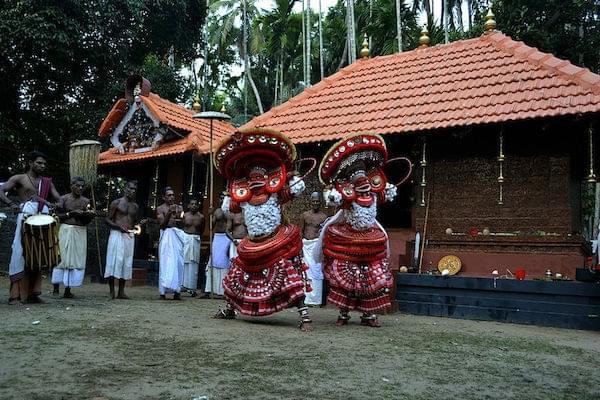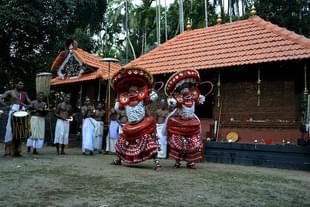Culture
The Shorter Epics Of India; And How The Epic Song Genre Has Shaped The Identities Of Communities
Subhash Kak
Aug 28, 2016, 02:27 PM | Updated 02:27 PM IST
Save & read from anywhere!
Bookmark stories for easy access on any device or the Swarajya app.


This is the third part in a four-part essay that delves into the various timeless epic song traditions of India and highlights their influence over Indian history and culture.
Guga is a popular epic of the Punjab. It is another story in which Prithviraj Chauhan and Gorakhnath are important figures.
Guga’s mother, Bachal, and her sister, Kachal, are both barren. Gorakhnath wishes to give Bachal some curds to drink to get her pregnant but at that time Kachal is impersonating her sister and twins are born to her. Now Gorakhnath asks his disciple Janamejaya to sacrifice himself by dissolving in water. Bachal drinks this and she gets pregnant. Kajal has no milk in her breasts, so Bachal nurses the twins from one breast and Guga from another. Guga’s powers come from Gorakhnath, a disciple of Shiva, and he is considered to be an incarnation of Janamejaya of the Mahabharata.
There are many heroic exploits by Guga as he grows up. But, eventually, the twins ask for their share of the kingdom and, to force the issue, seek Prithviraj’s help who arrives with his huge army, but the battle is a stalemate.
There are negotiations during which one of the twins spears Guga in the eye. In anger, Guga beheads the twins. When Bachal learns of the death of the twins, she is heart broken as she had treated the twins like her own sons. She banishes Guga for 12 years during which period he lives with Gorakhnath.
After 12 years, Guga begins to visit his wife surreptitiously. Bachal gets to know and she begs Guga to return home. But he refuses, saying that he will never show his face to her because she exiled him. He goes to Gorakhnath to ask him to open up the earth so that he could perform samadhi. That is what happens, and the earth swallows him and his blue stallion.
Guga is venerated as a supernatural hero in Punjab and its neighbouring states. He is most celebrated during the rainy season where large fairs are held at the Guga shrines. The mark of Guga is his blue horse. Blue flags represent his family whereas yellow flags are used to represent his maternal family. Guga singers are from the community of Bhagats, who accompany themselves with the drum and sarangi.
North of the Punjab, the epic songs in Kashmir are sung by the Bhands, who are a community of traditional performers. (Raina, 1999)
The word “bhand” seems to be derived from the bhana of Bharata’s Natya Shastra, in which it is a drama form. The enactments include mythological themes, and masks and large puppets are also used.
The orchestras includes the swarnai, dhol, nagara, and the thalij. The swarnai is larger in size than the better-known shehnai with a strong and metallic sound. It consists of a nai or wooden pipe, the barg, a reed, and a copper disc of the diameter of the pipe into which the barg is fitted. The Bhands dance to the tunes of specified mukams of Sufiana music (Kashmiri classical music). The performance, which includes dancing, acting, puppetry, acrobatic tricks, and music begins in the evening with a ritual dance and continues till the early hours of the next day. The all-night performance deals with the heroic exploits of the goddess. The Akanandun is a Kashmiri epic song with some parallels to the Guga story. Here, a barren queen conceives— thanks to Gorakhnath who returns in 12 years to reclaim the boy.
The South
Blackburn (1989) names the following major oral epics from the South:
Kordabbu from Karnataka; Kanyaka, Palnadu and Toubommalata from Andhra Pradesh; Annanmar, Muttupattan and Tampimar from Tamil Nadu; and Teyyam of Kerala. These are in addition to the classical Sanskrit epic-based performances in all the four states.
Kanyaka is only spoken of here which is the epic of the Komati community of Andhra. This tale is believed to be derived from the Skanda Purana, the Komatis considering themselves to be the descendents of the soldiers who form part of the story. Written versions of the epic do exist. In the story, the king of the area sees Kanyaka who is the daughter of the leader of the Komati clan. The king sends word that he would like to marry Kanyaka and, should the father refuse, he would invade the city and abduct her.
The Komatis do not know what to do. Kanyaka takes charge and asks for a delay. Meanwhile, she and the other women decide to immolate themselves. The king’s spies are so moved that they join sides with the Komatis. At last, the king invades the town, but it is too late and the women are dead. The king, when he enters the city, also dies because of a curse placed on him by Kanyaka.
Before she dies, Kanyaka demands that the Komatis will follow certain rules: cross-cousin marriages will never be avoided, even when the boy or the girl is sick or ugly or poor; all Komati girls will carry her name; and the city will be a pilgrimage centre with Kanyaka as a goddess.
Shorter Epics
Apart from the large epics, there is also the tradition of the short epic (khanda-kavya) which goes back to the Sanskrit period. These khanda-kavyas, which narrate specific episodes of a well-known story, are to be found in all regions of India.
Kuttu
It is performed by the Chakyars, a community of performing artistes in Kerala. The story is recited in a dramatic style with emphasis on eloquent declarations with appropriately suggestive facial expressions and hand gestures. The only accompaniments are the cymbals and the drum known as the mizhavu, made of copper with a narrow mouth over which skin is stretched. While narrating the story, the narrator Chakyar singly acts out the roles of various characters in the story. This narrative form turned into Kudiyattam— the Sanskrit theatre— during the course of its evolution.
Pandavani
This storytelling form from Chhatisgarh narrates the exploits of the five Pandava brothers. The team of Pandavani performers has one main narrator-singer and one or two co-singers, who also play on musical instruments like the tabla and the harmonium. The main singer-narrator holds in one hand a tambura which is decorated with small jingling bells and peacock feathers, and in the other a kartal.
Tal-maddale
This narrative drama of Karnataka is predecessor of the Yakshagana, a colourful dance-drama of the region. It is named after cymbal (tal) and drum (maddale). The chief narrator is called Bhagavata and his associates are called Arthadharis. Tal-maddale is a play without costumes, make-up, dance or acting and is performed in a sitting position.
Burra Katha
This popular narrative form of Andhra Pradesh is the the story narrated on the beat of the Burra drum. The traditional performers of the Burra Katha believe that they are descendants of Valmiki, the composer of the epic Ramayana.
Kirtana
This narrative form is popular in almost all parts of the country under different names such as Katha Kalakshepam, Harikatha and so on. Kirti is fame and its derivative “kirtana” means to praise and exalt. Often, kirtanas sing praises of divinity.
Oja-Pali
This is a very interesting form of storytelling in Assam which uses dramatic techniques to illustrate the narrative and enhance visual impact. This art form is associated with Manasa worship and with the telling of stories from the epics and the Puranas. The performers take many days to narrate the story which is divided into three parts— Deva Khanda, Baniya Khanda and Bhatiyali Khanda. The Oja is the main narrator-singer and the Palis are his associates or members of his chorus.
Villu Pattu
Literally meaning bow-song, this form of recitation (using a bow-shaped musical instrument) of Tamil Nadu developed in the 15th century. There are seven to eight persons in a bow-song party who form a kind of chorus that supports the main singer-narrator. The stories from the Ramayana, the Mahabharata and the Puranas are told in ballad style.
Daskathia And Chhaiti Ghoda
Daskathia is one of the several narrative forms from Orissa. The devotee dramatically narrates a story to the accompaniment of a wooden musical instrument called kathia. The chief narrator is called gayaka and his assistant is called palia.
A Chhaiti Ghoda troupe of performers is made up of two players on dhol and mohuri musical instruments and three characters. A dummy horse made of bamboo and cloth is used as a prop, the dancer entering its hollow body and dancing while the main singers go on with their narration.
Povada
In Maharashtra, the narrative khanda-kavya is called povada. The first available povada in Marathi was written on the thrilling episode of Shivaji slaying Afzal Khan. The tradition of povada singing has been kept alive by folk singers known as shahirs. The povada is presented in a dramatic manner— high-pitched singing and melodramatic acting are its soul. The shahir and his supporting singers play the duf and the tuntuni. The duf is like the Hindi dufli but only about six inches in diameter and made of thicker hide; the tuntuni is a one-stringed instrument. The povada is also sung by the Gondhali, who normally sing in praise of the goddess (Dhere, 1988).
The number of verses may be as few as 20 but, by tradition, 300 verses or more is the norm. A povada must record the correct historical dates and names in the events it depicts. It is a vira-shri form of song to exhort a people to battle and to honour a hero, or to lament a defeat by foul means. Panipat cha phatka (the blow of Panipat, on Prithviraj Chauhan) is probably the best known povada. It is necessarily a virile form of poetry— there are povadas on Krishna in the battlefield but none on Buddha; people have written povadas on Gandhi, too, but depicting events of confrontation like the Salt March and ignoring the philosophy of ahimsa.
A povada is also a metre. A long poem that fulfills the other criteria but is not in the povada metre is merely a poem. Adnyandaas is the best known shahir. His most famous povadas are Afzalkhanacha Vadha (the killing of Afzalkhan) and Agryahun Sutka (Shivaji’s escape from Agra).
One of the earliest povada poets was the Hindi poet Kaviraj Bhushan, who not only wrote Shiva-Bani but also influenced the povada tradition immeasurably. The story of how he travelled to Maharashtra starts with Bhushan eating lunch. He told his elder sister-in-law that the food lacked enough salt. She laughed and said, “Pehle namak kama ke to lao.” (first earn some salt).
He is said to have walked out that very minute and proceeded to the king Chhatrasal, who told him not to waste his time on minor figures like himself and go to Chhatrapati Shivaji instead. When Bhushan sang his song in the darbar, Shivaji was so pleased that he told him to ask for anything he wanted. Bhushan asked for 80 sacks of salt to be delivered to his sister-in-law. Bhushan’s samadhi is in a tiny village called Ateet in Maharashtra.
This essay was originally presented at the seventh International Conference and Festival of Asian Music, Busan, Korea during 26-30 September 2002 and has been republished here with permission.
Read Also:
The Enduring Appeal Of The Great Indian Epic Song Tradition
Rich In Storytelling: The Song Traditions Of Rajasthan, Gujarat And The Ganga Plains
Subhash Kak is Regents professor of electrical and computer engineering at Oklahoma State University and a vedic scholar.





